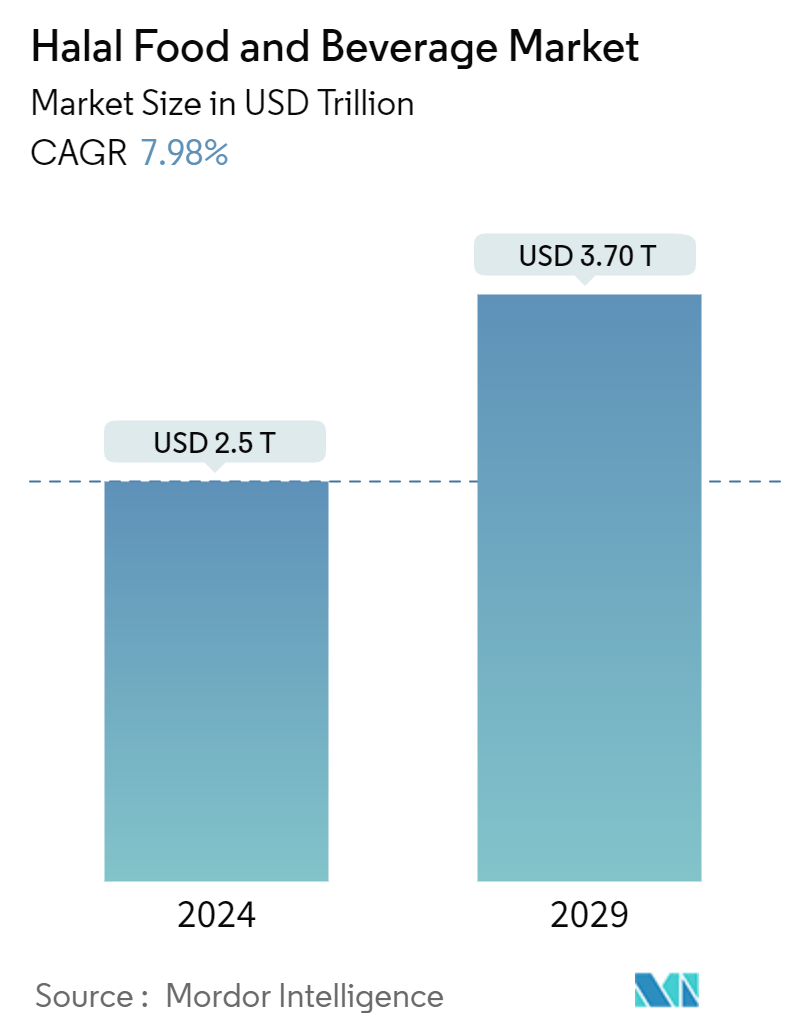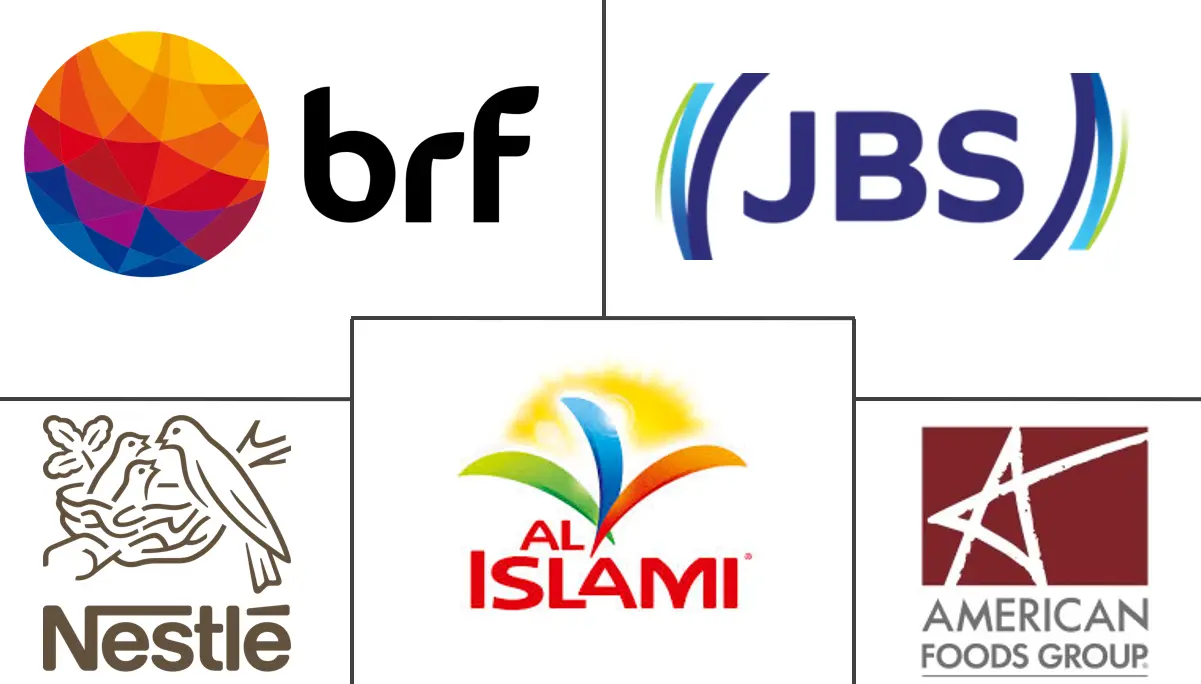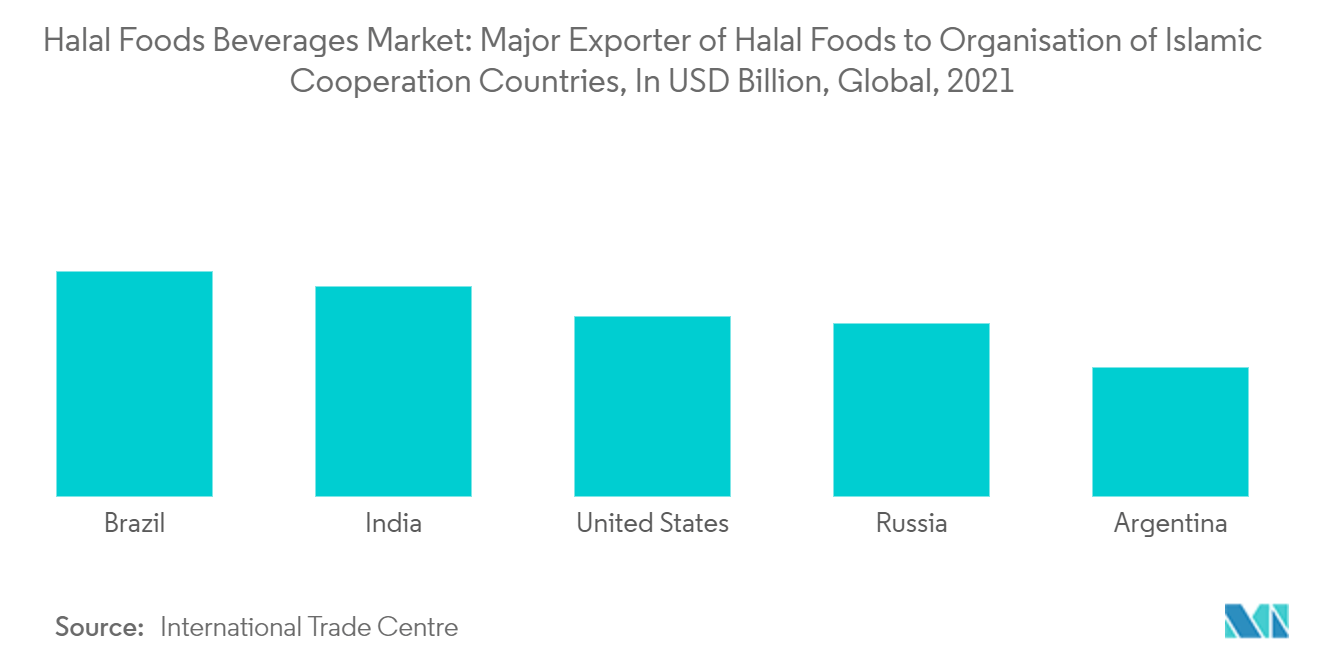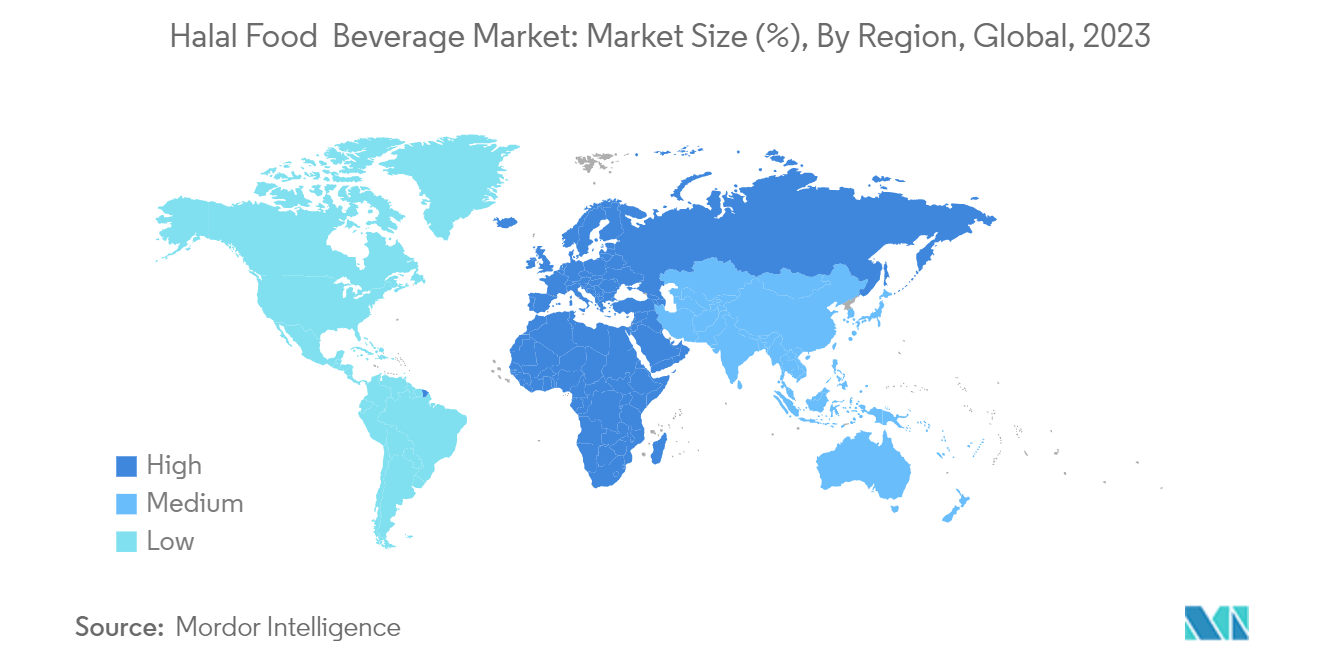Halal Food & Beverage Market Size

| Study Period | 2019 - 2029 |
| Market Size (2024) | USD 2.5 Trillion |
| Market Size (2029) | USD 3.70 Trillion |
| CAGR (2024 - 2029) | 7.98 % |
| Fastest Growing Market | Asia Pacific |
| Largest Market | Middle East and Africa |
Major Players
*Disclaimer: Major Players sorted in no particular order |
Halal Food & Beverage Market Analysis
The Halal Food & Beverage Market size is estimated at USD 2.5 trillion in 2024, and is expected to reach USD 3.70 trillion by 2029, growing at a CAGR of 7.98% during the forecast period (2024-2029).
The halal foods and beverages market is experiencing significant growth globally, driven by the rising demand for products that comply with Islamic dietary laws. Halal certification ensures that food and beverages are prepared according to strict religious guidelines, making them permissible for Muslims to consume. This market is expanding in predominantly Muslim countries and gaining traction in regions like North America and Europe, where an increasing number of consumers are seeking out halal-certified products for their perceived quality, ethical standards, and health benefits.
Companies across various sectors are recognizing the potential of the halal food and beverage market and are launching new ventures to tap into this lucrative segment. For instance, in October 2022, the Public Investment Fund (PIF) announced the launch of the Halal Products Development Company. This initiative aims to enhance the efficiency of the Saudi Arabian halal production industry, promote local innovation, and support global exports. Leveraging Saudi Arabia's significant position in the Islamic world, the company seeks to strengthen the local halal ecosystem. The Middle East is a significant producer and consumer of halal food, with countries investing in developing the sector to meet local and international demand.
Halal Food & Beverage Market Trends
The Increasing Demand for Halal Food Among Consumers
The demand for halal food is witnessing a significant upsurge globally, particularly among Muslim consumers who adhere to Islamic dietary laws. Halal food, which must be sourced, prepared, and processed according to specific guidelines outlined in Islamic scripture, represents a substantial portion of this market. In addition to traditional food offerings, there is growing interest in halal-certified meat alternatives, catering to dietary preferences and ethical considerations.
In response to this heightened demand, companies are increasingly focusing on expanding their offerings in the halal food segment. For instance, in November 2023, Deli Halal launched its 89 new line of halal-certified sliced deli meats in supermarket chains like Giant Food Stores and Stop & Shop Supermarkets. The availability of such products underscores the industry's commitment to innovation and catering to consumers' evolving preferences.
Furthermore, the popularity of halal food extends beyond religious adherence, with an increasing number of non-Muslim consumers also opting for these products. Halal-certified offerings are often perceived as cleaner, ethical, and of higher quality, appealing to a broader audience concerned about food sourcing and production practices. As a result, companies in the halal food industry are capitalizing on this trend by diversifying their product portfolios and expanding their distribution networks to reach a wider demographic. With the continued growth of halal-certified meat and meat alternative options, the market is expected to further expand and innovate in the coming years.

Middle East and Africa Emerges as the Largest Market
Middle East and Africa emerged as the largest market for Halal products, driven by a substantial Muslim population and rising demand for halal-compliant goods. According to the Embassy of the UAE in Washington, DC, over 75% of UAE residents were Muslim as of 2023, underscoring the significance of halal products in daily life.
Consumers in the region demand Halal certification, which ensures adherence to Islamic dietary laws, offering peace of mind and trust in the food consumed. Consumers in this region seek products that align with their religious beliefs, emphasizing the importance of purity, cleanliness, and ethical sourcing. This demand extends beyond food, including cosmetics, pharmaceuticals, and other consumables.
Due to the increasing demand, companies are expanding their offerings. For instance, in August 2023, Al Islami re-launched its premium products in Qatar’s esteemed markets. Upholding the highest Halal standards, Al Islami reintroduced its signature Chicken Griller and various Chicken Parts, including drumsticks, breasts, and thighs. This re-launch highlights the company's dedication to providing diverse, high-quality halal options. The robust demand for halal products in Middle East and Africa underscores the region's potential as a leading market, attracting businesses keen on meeting Muslim consumers' stringent requirements and preferences.

Halal Food & Beverage Industry Overview
The halal foods and beverages market is highly competitive, with several players competing to get a major share of the market. Leading players, like Nestlé SA, Al Islami Foods, BRF SA, and American Foods Group LLC, have a wide geographic presence supported by brand loyalty among the consumers, which gives these companies an upper edge over their competitors. Major manufacturers are operating in the market, expanding their presence and developing various flavors in various product segments to cater to consumers' needs. Moreover, brand awareness among consumers gives them a competitive advantage in the market. Alongside this, these companies mention the presence of halal certification to gain consumers' trust.
Halal Food & Beverage Market Leaders
-
Nestlé SA
-
Al Islami Foods
-
BRF SA
-
American Foods Group, LLC
-
JBS SA
*Disclaimer: Major Players sorted in no particular order

Halal Food & Beverage Market News
- February 2024: CJ Foods launched its first halal Bibigo Mandu products. The company aims to bring the authentic taste of Korean Mandu, which dominates the market in South Korea, the United States, and Vietnam, to Malaysian consumers.
- February 2024: Industronics Bhd, an electronics manufacturer, entered the halal food and beverage and halal convenience store market in Hong Kong. The company acquired a dormant Hong Kong firm from Datuk Chu Boon Tiong and rebranded it as Halal Group Ltd (HGL) for this new venture.
- April 2023: Individually frozen halal chicken thighs from Crescent Foods were made available in five-pound re-sealable bags and are cooked from frozen to USDA-recommended temperatures.
Halal Foods & Beverages Market Report - Table of Contents
1. INTRODUCTION
- 1.1 Study Assumptions and Market Definition
- 1.2 Scope of the Study
2. RESEARCH METHODOLOGY
3. EXECUTIVE SUMMARY
4. MARKET DYNAMICS
-
4.1 Market Drivers
- 4.1.1 Growing Muslim Population Supporting Demand
- 4.1.2 Halal Certification Introducing a New Consumer Base
-
4.2 Market Restraints
- 4.2.1 Fraudulence Associated with Mislabeling Halal Meat Products
-
4.3 Porter's Five Forces Analysis
- 4.3.1 Threat of New Entrants
- 4.3.2 Bargaining Power of Buyers/Consumers
- 4.3.3 Bargaining Power of Suppliers
- 4.3.4 Threat of Substitute Products
- 4.3.5 Intensity of Competitive Rivalry
5. MARKET SEGMENTATION
-
5.1 By Type
- 5.1.1 Halal Food
- 5.1.2 Halal Beverages
- 5.1.3 Halal Supplements
-
5.2 By Distribution Channel
- 5.2.1 Supermarkets and Hypermarkets
- 5.2.2 Convenience Stores
- 5.2.3 Online Retail Stores
- 5.2.4 Other Distribution Channels
-
5.3 Geography
- 5.3.1 North America
- 5.3.1.1 United States
- 5.3.1.2 Canada
- 5.3.1.3 Mexico
- 5.3.1.4 Rest of North America
- 5.3.2 Europe
- 5.3.2.1 Germany
- 5.3.2.2 United Kingdom
- 5.3.2.3 Spain
- 5.3.2.4 France
- 5.3.2.5 Italy
- 5.3.2.6 Russia
- 5.3.2.7 Rest of Europe
- 5.3.3 Asia-Pacific
- 5.3.3.1 China
- 5.3.3.2 Japan
- 5.3.3.3 India
- 5.3.3.4 Australia
- 5.3.3.5 Indonesia
- 5.3.3.6 Malaysia
- 5.3.3.7 Singapore
- 5.3.3.8 Rest of Asia-Pacific
- 5.3.4 South America
- 5.3.4.1 Brazil
- 5.3.4.2 Argentina
- 5.3.4.3 Rest of South America
- 5.3.5 Middle East and Africa
- 5.3.5.1 South Africa
- 5.3.5.2 Egypt
- 5.3.5.3 Saudi Arabia
- 5.3.5.4 United Arab Emirates
- 5.3.5.5 Oman
- 5.3.5.6 Rest of Middle East and Africa
6. COMPETITIVE LANDSCAPE
- 6.1 Most Adopted Strategies
- 6.2 Market Share Analysis
-
6.3 Company Profiles
- 6.3.1 Nestle SA
- 6.3.2 JBS SA
- 6.3.3 BRF SA
- 6.3.4 Ferrero International SA
- 6.3.5 Midamar Corporation
- 6.3.6 Crescent Foods Inc.
- 6.3.7 Tahira Foods Ltd
- 6.3.8 Tanmiah Food Company
- 6.3.9 American Foods Group LLC
- 6.3.10 Al Islami Foods
- *List Not Exhaustive
7. MARKET OPPORTUNITIES AND FUTURE TRENDS
** Subject To AvailablityHalal Food & Beverage Industry Segmentation
Halal food and beverages constitute products prepared strictly by Islamic dietary law. Halal products are considered lawful and hygienic. The halal foods and beverages market is segmented by type, distribution channel, and geography. By type, the market is segmented into halal food, halal beverages, and halal supplements. By distribution channel, the market is segmented into supermarkets and hypermarkets, convenience stores, online retail stores, and other distribution channels. Furthermore, by geography, the market is segmented into North America, Europe, Asia-Pacific, South America, and Middle East and Africa. The market sizing has been done in value (USD) for all the abovementioned segments.
| By Type | Halal Food | |
| Halal Beverages | ||
| Halal Supplements | ||
| By Distribution Channel | Supermarkets and Hypermarkets | |
| Convenience Stores | ||
| Online Retail Stores | ||
| Other Distribution Channels | ||
| Geography | North America | United States |
| Canada | ||
| Mexico | ||
| Rest of North America | ||
| Geography | Europe | Germany |
| United Kingdom | ||
| Spain | ||
| France | ||
| Italy | ||
| Russia | ||
| Rest of Europe | ||
| Geography | Asia-Pacific | China |
| Japan | ||
| India | ||
| Australia | ||
| Indonesia | ||
| Malaysia | ||
| Singapore | ||
| Rest of Asia-Pacific | ||
| Geography | South America | Brazil |
| Argentina | ||
| Rest of South America | ||
| Geography | Middle East and Africa | South Africa |
| Egypt | ||
| Saudi Arabia | ||
| United Arab Emirates | ||
| Oman | ||
| Rest of Middle East and Africa |
Halal Foods & Beverages Market Research FAQs
How big is the Halal Food & Beverage Market?
The Halal Food & Beverage Market size is expected to reach USD 2.5 trillion in 2024 and grow at a CAGR of 7.98% to reach USD 3.70 trillion by 2029.
What is the current Halal Food & Beverage Market size?
In 2024, the Halal Food & Beverage Market size is expected to reach USD 2.5 trillion.
Who are the key players in Halal Food & Beverage Market?
Nestlé SA, Al Islami Foods, BRF SA, American Foods Group, LLC and JBS SA are the major companies operating in the Halal Food & Beverage Market.
Which is the fastest growing region in Halal Food & Beverage Market?
Asia Pacific is estimated to grow at the highest CAGR over the forecast period (2024-2029).
Which region has the biggest share in Halal Food & Beverage Market?
In 2024, the Middle East and Africa accounts for the largest market share in Halal Food & Beverage Market.
What years does this Halal Food & Beverage Market cover, and what was the market size in 2023?
In 2023, the Halal Food & Beverage Market size was estimated at USD 2.30 trillion. The report covers the Halal Food & Beverage Market historical market size for years: 2019, 2020, 2021, 2022 and 2023. The report also forecasts the Halal Food & Beverage Market size for years: 2024, 2025, 2026, 2027, 2028 and 2029.
Halal Food & Beverage Industry Report
Statistics for the 2024 Halal Food & Beverage market share, size and revenue growth rate, created by Mordor Intelligence™ Industry Reports. Halal Food & Beverage analysis includes a market forecast outlook to 2029 and historical overview. Get a sample of this industry analysis as a free report PDF download.



